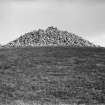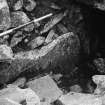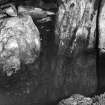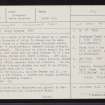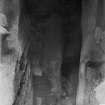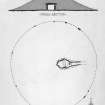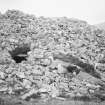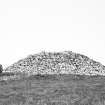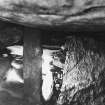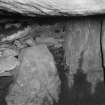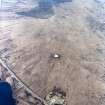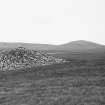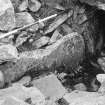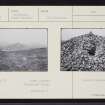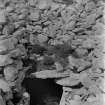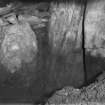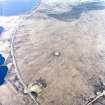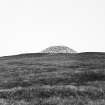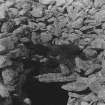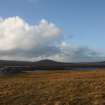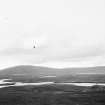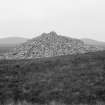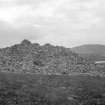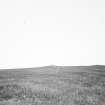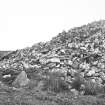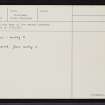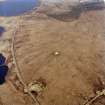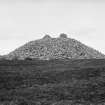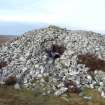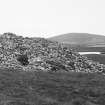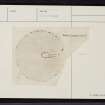North Uist, Barpa Langass
Chambered Cairn (Neolithic)
Site Name North Uist, Barpa Langass
Classification Chambered Cairn (Neolithic)
Alternative Name(s) Bharpa Langass; Ben Langass; Barpa Langais
Canmore ID 10236
Site Number NF86NW 6
NGR NF 83766 65733
Datum OSGB36 - NGR
Permalink http://canmore.org.uk/site/10236
- Council Western Isles
- Parish North Uist
- Former Region Western Isles Islands Area
- Former District Western Isles
- Former County Inverness-shire
Barpa Langass, 3rd millennium bc The tumulus of some eminent warrior, or perhaps of a Neolithic tribe, this is one of the best survivals of a barpa or massive chambered cairn of the passage-grave type. Prominent on the hillside, the circular mound of stones conceals the only known intact megalithic chamber in the Western Isles.
Taken from "Western Seaboard: An Illustrated Architectural Guide", by Mary Miers, 2008. Published by the Rutland Press http://www.rias.org.uk
NF86NW 6 8376 6573.
(NF 8381 6571) Barpa Langass (NR)
OS 6" map, Inverness-shire, 2nd ed., (1904)
Barpa Langass is a cairn 14ft high and edged by a peristalith 80ft in diameter of which 14 stones can be seen. On the E side there is a funnel-shaped forecourt within which is a mass of cairn material removed during attempts to find the passage. The latter is intact except for the outer few feet, and leads into an oval chamber 13ft 3ins long by 6ft wide, roofed with three lintels.
E Beveridge (1911) found evidence of burnt burials, sherds and wood ash in debris removed from the interior. In the late 19th century a second chamber was said to be attainable by a passage from the N side.
Finds, in the NMAS, include Beaker and IA, or later, shreds, a few flints, a barbed and tanged arrowhead, and burnt bone (presumably human).
A S Henshall 1972; E Beveridge 1911; V G Childe 1940.
This chambered cairn is as described and planned by Henshall. Nothing was seen of the second chamber.
Surveyed at 1/10,560.
Visited by OS (J T T) 10 June 1965.
Field Visit (4 September 1914 - 24 July 1924)
Chambered Cairn, Barpa Langass, Ben Langass.
About 400 yards south of the road some 7 miles west-south-west of Lochmaddy, on the north-western slope of Ben Langass, at an elevation of about 130 feet above sea level, is a chambered cairn knows as Barpa Langass. The monument is in a very good state of preservation; the main structure of stones, devoid of soil or vegetation, seems intact except for several cavities on the surface of the mound, from which the stones have been displaced, and for some damage at the exterior end of the entrance passage, from which the lintels have been removed. Previous to the erection of the structure the site had been levelled by excavation on the higher or south-eastern side, the excavated hollow extending some 5 ½ feet beyond the mound and measuring 2 ½ feet in height on the counterscarp. The cairn is circular and measures 80 feet in diameter and 14 feet in height, the outline being marked at irregular intervals by small slabs set on end, chiefly on the northern arc. These boundary slabs have an average height of about 2 feet and are placed from 9 ½ feet to 30 feet apart, although two towards the south-east are only separated by a distance of 4 ¼ feet. (Fig. 131 [SC 1106515])
In the east side of the cairn the entrance passage to a perfect megalithic chamber is exposed, the outer part of the passage for a distance of about 19 feet having the lintels removed and being blocked up with fallen stone. The passage, the walls of which are chiefly formed of slabs set on edge, continues in a straight course for a further 6 feet where the chamber is entered at its south-east corner. The outer section of the passage has been low-roofed and some 2 feet 9 inches in width. Its height is not ascertainable. As already stated the lintels have been removed, but where the first of the remaining lintels, a stone 5 feet long by 4 feet 5 inches broad by 9 ½ inches thick, is seen in position, the passage measures 2 feet 10 inches wide. From this point to the inner doorway of the chamber the south wall is formed mainly of one large slab 5 ¾ feet in length, while the opposite side is built of smaller stones. At the doorway of the chamber the roof of the passage rises to a height of 5 ¾ feet and its width contracts to 2 feet2 inches at the top and 1 foot 7 inches at the bottom. A pillar, 1 foot wide by 6 inches thick by 1 foot 5 inches at the ingoing, forms the northern jamb. The southern wall of the chamber is not continued in the line of the south wall of the passage but stands 20 inches farther north. The chamber measures 9 ¼ feet from east to west and 6 feet from north to south and its height varies from about 6 feet at the entrance to over 7 feet at the opposite northwest corner. The walls of the chamber consist of five slabs of large size, one on the south side measuring 4 feet 7 inches in length and 5 feet in height, the opposite slab 5 feet by 6 ¼ feet, the two in the west end 3 feet 8 inches and 3 feet 4 inches in width respectively, and one in the east end 21 feet. Two of the slabs do not reach the roof, but the vacancies between the slabs themselves and between the short ones and the roof are carefully built up with smaller stones. Two very large slabs placed across from north to south form the roof, with a third superimposed to cover a gap of 1 foot 4 inches between the first two. (Figs. 129, 130 [SC 1106514, SC 1106512])
The chamber and passage occupy only a small portion of the cairn, and it is quite likely that, as reported, there is another chamber in the northern part of the mound.
Several fragments of thin pottery with ornamentation apparently belonging to three different vessels. wood ashes, burnt bones, a calcined flint barbed arrowhead, a scraper and five other flakes of flint as well as a thin disc of talc 1 foot 4 inches in diameter, pierced with two holes close together near the edge, were found among debris removed from the chamber and are now preserved in the National Museum.
RCAHMS 1928, visited 4 September 1914 and 24 July 1924.
OS map: North Uist xl.
Publication Account (1985)
Barpa Langass, a large cairn some 25m in diameter and 4m in height, on the western slopes of Ben Langass, is immediately obvious to anyone passing along the Lochmaddy-Clachan road; a passage-grave, it is the only chambered cairn in the Western Isles which is known to retain its chamber intact. Kerb-stones may still be seen in places around the circular cairn, especially on the northern side, and the line of stones forming the north side of the forecourt is still visible. The passage itself is about 4m long; some of the lintels are missing from the outer end, which is partially blocked by fallen stones. The walls are formed by large slabs with some drystone walling above. At the inner end, a tall stone supporting a broken roofmg slab partially blocks the passage. The chamber is oval on plan, measuring 4m by 1.8m, and is formed of very large upright slabs with drystone walling between and above them. Excavation in the early years of this century produced some sherds of beaker pottery, a flint arrowhead and flakes as well as burnt bones.
Walk south-east for 1km or directly east to the top of Ben Langass and then south down the hill towards the loch to find the stone 'circle' Pobull Fhinn (NF 842650). The monument may also be approached by following the track to Langass Lodge and continuing along the slope on much the same line.
Pobull Fhinn, on the southern slopes of Ben Langass, is an oval setting of irregular shaped stones, enclosing an area which has been partially terraced; the slope is cut into on the uphill side and possibly built up a little on the downhill side.
Information from ‘Exploring Scotland’s Heritage: Argyll and the Western Isles’, (1985).
Watching Brief (16 February 2009 - 19 February 2009)
NF 844 657 A watching brief was carried out on 16–19 February 2009 during the extraction of gravel for the
construction of a footpath. The extraction pits were on the northern flank of Beinn Langais, an area that was the focus for activity throughout the Neolithic period. There are two scheduled ancient monuments less than 600m from the pits; Pobuill Fhinn a stone circle (NF86NW 7), and Barpa Langass (NF86NW 6), an early Neolithic chambered burial cairn. Evidence for an early settlement, of Neolithic or perhaps even earlier date, had been discovered during widening of the main road c800m to the N of the site. No features of archaeological
significance were found during the excavation of the four gravel pits.
Archive: RCAHMS (intended). Report: CNES SMR and RCAHMS
Funder: North Uist Woodland Trust
Kate MacDonald and Rebecca Rennell – Uist Archaeology
Field Visit (5 March 2010)
This chambered cairn is as described and planned by Henshall and is protected as a scheduled ancient monument. It is an impressive mound of grey stones, standing on the hillside looking NW across Loch a’ Bharpa. A peristalith of spaced slabs defines its perimeter, but this lies some way out from the steep flanks of the mound covering the chamber, suggesting that a certain amount of disturbance and reconstruction has taken place, so much so that the capstones are buried beneath a far greater depth of cairn material than has been observed elsewhere. The passage approaches the chamber from the E and has evidently undergone some reconstruction at its inner end, work that possibly also includes the coursed masonry forming its N wall. The cairn gives the appearance of standing in a shallow hollow, but this seems to be the result of differential peat growth, which has not encroached upon the better-drained matrix of the cairn material.
Visited by RCAHMS (ARG,SPH) 5 March 2010


















































